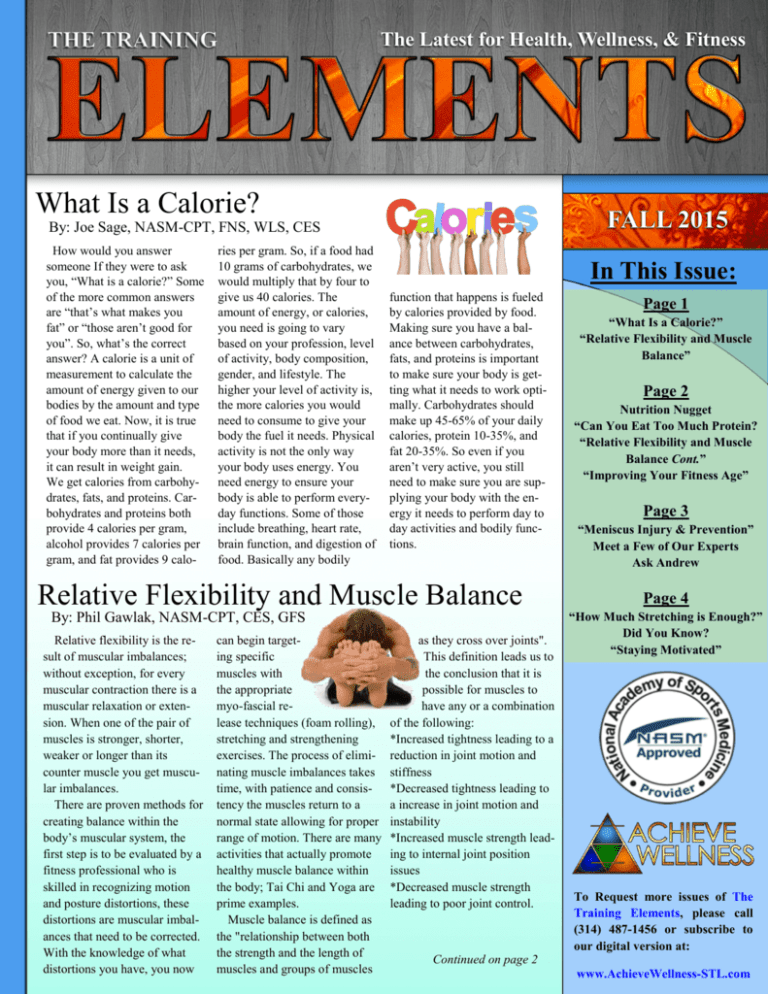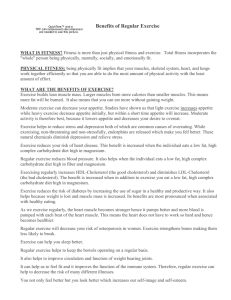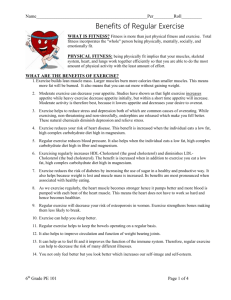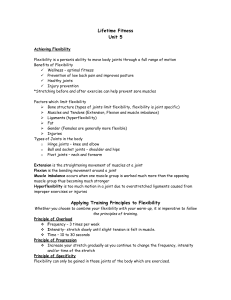Fall 2015 - achievewellness
advertisement

What Is a Calorie? By: Joe Sage, NASM-CPT, FNS, WLS, CES How would you answer someone If they were to ask you, “What is a calorie?” Some of the more common answers are “that’s what makes you fat” or “those aren’t good for you”. So, what’s the correct answer? A calorie is a unit of measurement to calculate the amount of energy given to our bodies by the amount and type of food we eat. Now, it is true that if you continually give your body more than it needs, it can result in weight gain. We get calories from carbohydrates, fats, and proteins. Carbohydrates and proteins both provide 4 calories per gram, alcohol provides 7 calories per gram, and fat provides 9 calo- ries per gram. So, if a food had 10 grams of carbohydrates, we would multiply that by four to give us 40 calories. The amount of energy, or calories, you need is going to vary based on your profession, level of activity, body composition, gender, and lifestyle. The higher your level of activity is, the more calories you would need to consume to give your body the fuel it needs. Physical activity is not the only way your body uses energy. You need energy to ensure your body is able to perform everyday functions. Some of those include breathing, heart rate, brain function, and digestion of food. Basically any bodily In This Issue: function that happens is fueled by calories provided by food. Making sure you have a balance between carbohydrates, fats, and proteins is important to make sure your body is getting what it needs to work optimally. Carbohydrates should make up 45-65% of your daily calories, protein 10-35%, and fat 20-35%. So even if you aren’t very active, you still need to make sure you are supplying your body with the energy it needs to perform day to day activities and bodily functions. Relative Flexibility and Muscle Balance By: Phil Gawlak, NASM-CPT, CES, GFS Relative flexibility is the result of muscular imbalances; without exception, for every muscular contraction there is a muscular relaxation or extension. When one of the pair of muscles is stronger, shorter, weaker or longer than its counter muscle you get muscular imbalances. There are proven methods for creating balance within the body’s muscular system, the first step is to be evaluated by a fitness professional who is skilled in recognizing motion and posture distortions, these distortions are muscular imbalances that need to be corrected. With the knowledge of what distortions you have, you now can begin targeting specific muscles with the appropriate myo-fascial release techniques (foam rolling), stretching and strengthening exercises. The process of eliminating muscle imbalances takes time, with patience and consistency the muscles return to a normal state allowing for proper range of motion. There are many activities that actually promote healthy muscle balance within the body; Tai Chi and Yoga are prime examples. Muscle balance is defined as the "relationship between both the strength and the length of muscles and groups of muscles as they cross over joints". This definition leads us to the conclusion that it is possible for muscles to have any or a combination of the following: *Increased tightness leading to a reduction in joint motion and stiffness *Decreased tightness leading to a increase in joint motion and instability *Increased muscle strength leading to internal joint position issues *Decreased muscle strength leading to poor joint control. Continued on page 2 Page 1 “What Is a Calorie?” “Relative Flexibility and Muscle Balance” Page 2 Nutrition Nugget “Can You Eat Too Much Protein? “Relative Flexibility and Muscle Balance Cont.” “Improving Your Fitness Age” Page 3 “Meniscus Injury & Prevention” Meet a Few of Our Experts Ask Andrew Page 4 “How Much Stretching is Enough?” Did You Know? “Staying Motivated” To Request more issues of The Training Elements, please call (314) 487-1456 or subscribe to our digital version at: www.AchieveWellness-STL.com Relative Flexibility and Muscle Balance ...continued Myth: A high protein diet will increase muscle mass and promote greater fat loss. Fact: While it is true that an increase in exercise will create more of a demand for protein in the diet, the body relies on the correct amount of carbohydrates, proteins, and fats to maintain and repair itself. Resistance training will increase the amount of repair material (proteins) the body needs. Therefore, an individual performing resistance training will need more protein than a sedentary individual. Can You Eat Too Much Protein? By: Sean Cristea, NASM-CPT, FNS, CES, PES Myth: As far as weight is concerned, you cannot eat too much protein. Anything beyond what your body needs will get excreted in urine Muscle imbalances are also seen between the larger outer muscles that control major movement of a joint and the smaller internal muscles that are more responsible for deep stability and control. Joints in the body have a complex inter-relationship between these internal and external muscles that can lead to problems if these relationships become unbalanced. It is vital that all health enthusiasts appreciate that fitness is not all about training the larger muscles and having a great set of "pecs and delts" – as effective training is about balancing your body with a variety of exercises and movements that focus equal attention to the smaller muscles tasked with maintaining stable joint posture as is placed on the larger and more obvious muscle groups. Remember - if you are at all concerned about muscle imbalance issues see your Physiotherapist or Corrective Exercise Specialist BEFORE symptoms of pain and injury appear. Logic: Because the body has little capacity to store proteins, it makes sense that anything consumed beyond what the body immediately needs will be excreted in the urine (similar to water – soluble vitamins) The Science: It is true that the body has limited ability to store protein. It is also true that a portion of the protein does get excreted in the urine (the nitrogen group that shows up in urine as urea). However, the other portion of the protein (the carbon group) is readily converted to glucose or fat, depending on the body’s current needs. Ultimately, protein consumed beyond what the body needs has the same fate as excess carbohydrate or fat – conversion into stored fat. Improving Your Fitness Age By: Sue Harrison, NASM-CPT Exercise makes you feel younger. Okay, okay, all you “exercisers” out there know that this isn’t really a news flash. But recent studies have shown it’s actually true. “Fitness age” is an idea that was developed by the Norwegian University of Science and Technology in its studies of thousands of Norwegians of all ages. Generally speaking, the concept of “fitness age” is that people with above-average cardiovascular fitness generally have longer life spans than people with lower aerobic fitness, and vice-versa. The Norwegian research was the basis for the development of fitness calculators, which Page 2 are easy to use and readily available online at no cost. This year the idea of fitness calculation was put to the test on a special population of older adults: 4,200 participants at the Senior Olympic Games. Dr. Pamela Peeke an assistant professor of medicine at the University of Maryland and Ulrik Wisloff, the scientist who led the development of the fitness age calculator, got together to study the fitness age of the Senior Olympians. The results were impressive. “While the athletes’ average chronological age was 68, their average fitness age was 43.” Yes, you read that right: the average Senior Olympian’s fitness age was 25 years younger than his/her chronological age! The substantial difference in the chronological age vs. the fitness age of the Senior Olympic study should serve as inspiration for all as to the substantial benefits of fitness at any age! Meniscus Injury & Prevention By: Caleb Koster, NASM-CPT, CES, PES, SFS A torn meniscus is one of the most common knee injuries, with more than 3 million reported cases annually in the US. The Meniscus is a Cshaped disc of cartilage that cushions the femur and tibia at the knee joint. An injury can occur when there is a tear in the cartilage due to incorrect movement or improper weight distribution. When this injury happens the cartilage cannot support the weight between femur and tibia. An example of this would be twisting or rotating the knee while keeping your foot planted. Elderly and those who play sports are at an increased risk for injury. Symptoms can include pain or swelling around the knee joint, a clicking noise, and/ or inability to bear weight on the affected side. There are training and strengthening techniques that can be used to help prevent and also heal a menis- cus tear. Assessments can be performed to see if there is pain when certain movements are performed involving the knee joint. If a tear has happened, you need to strengthen and recondition the muscles around it in order to prevent the injury from worsening and to help it heal. Stability, core, and balance training would help assist in preventing a tear from happening. When performing exercises, keeping the feet straight and the knees in line with the feet will help ensure the knee is moving correctly. Focusing on good form and posture will help maintain proper movement patterns which will decrease the risk of injury. MEET A FEW OF OUR EXPERTS Sue Harrison, NASM-CPT After 14 years as a prosecutor, followed by 15 years as a fulltime mom and volunteer, I decided to become a personal trainer to help others enjoy the benefits and joys of healthy living. Joe Sage, NASM-CPT, FNS, WLS, CES I live to inspire and help people reach there wellness goals and enjoy running, lifting weights, and taking on new challenges. Living a healthy and active life has always been something I believe anyone can do. Caleb Koster, NASM-CPT, CES, PES, SFS I began to assist others in achieving their fitness goals when I joined the Army, in 2011. Having been overweight and injured in the past, I understand what is necessary to lose fat and properly rehab injuries. Andrew Mills, NASM-CPT, FNS, CES, PES, and Master Trainer Q: I would like to workout, but I am so busy with work and kids. What can I do to workout and lose weight with no time to spare? -Tina K. A: Great question, Tina! This is a complex issue that plagues most Americans. Traditionally we have been taught to manage time. Unfortunately, time is not within our ability to control. I recommend we focus on managing priorities instead. When we take the time to list what we find most valuable—like career, family, and health for example—most of us will find ourselves spending valuable time on tasks that seem urgent, but are not relative to what is important. This is one way to create extra time in your day. Also, it is important to remember exercise is cumulative. This means you can elevate your heart through physical activity here and there throughout your day and it still counts! Lastly, the most important aspect of weight management is a proper nutrition plan that supports your current lifestyle, even if it is not currently an active one. Designing a custom nutrition plan designed to support your lifestyle can be a mind boggling journey full of misinformation. I recommend seeking professional advise in developing a well balanced plan fit to your needs. If you have a question that you would like answered in the next issue of The Training Elements, e-mail your question to: Andrew@AchieveWellness-STL.com Page 3 How Much Stretching is Enough? By: Kerry Steach, NASM-CPT, CES Flexibility is defined as the ability to move joints at their full range of motion, and is important for several reasons. Without enough flexibility, daily routines become difficult and, over time, the body begins to compensate leading to improper joint mechanics. Maintaining a flexible body decreases physical pain and prevents injury. Research suggests that the risk of injury is reduced when people follow a proper flexibility-training routine. Regular flexibility training can also help reduce stress in active muscles and relieve tension in overused areas. Flexibility is also a form of active recovery that improves mental states and helps soothe unstable emotions. If you find yourself experiencing any of the following, it may be a good indication for the need to begin implementing more flexibility training into your fitness program. Joint stiffness, poor posture muscle or joint pain, chronic stress, back, shoulder and neck pain For guidance, I have adopted the concept of FITT for flexibility training, as follows – Time The length of a stretch depends on both the type of stretch and activity. In general, a flexibility routine should last a minimum of 5 minutes and should target the major muscles groups. At a minimum, static stretches and poses should be held for 30 seconds. Frequency Generally an 5-10min flexibility routine four to seven days a week is recommended. It is also ideal to conduct flexibility training pre and post workouts. Type The best flexibility training programs incorporate multiple forms of stretching based on the goals and needs of the person. The timing and the types of stretches utilized should be based on the findings of an evaluation, the goals of the program and when the stretches will be Intensity Stretching should never be painful – stretches used. The four types of stretching used at should be held to a point of slight tension. Achieve Wellness to accompany selfProper breathing is highly important to optimyofascial release (foam rolling) are static mize the stretch – practice a big deep inhale stretching, neural-muscular stretching, activewith a 1 second pause followed by a slow long isolated stretching and dynamic stretching. exhale with another 1 second pause between breaths. DID YOU KNOW? FACT: According to the CDC, 80% of American adults do not get the recommended daily amount of physical activity. It’s recommended that adults get at least 2.5 hours of moderate-intense aerobic activity each week, and also perform resistance training exercises. Staying Motivated! By: Sue Harrison, NASM-CPT Do you have a desire to lose weight? Improve your figure? Keep heart disease, cancer or diabetes at bay? Lower your blood pressure or cholesterol? Protect your bones? Or are you just trying to live to a healthy old age? This might sound like an uninspired script for an infomercial, but of course you know these are all reasons people turn to exercise. And while these are all great reasons to exercise, recent research has shown that if you’re looking for the best motivation for exercising, it’s none of the above! It turns out your biggest motivator is: exercise makes you feel great! Yep, it’s as simple as that: you should exercise because it feels good—now. The health benefits that you will eventually reap on top of that are just the icing on the cake. A recent study at the University of Wales found that while many people begin to exercise as way to lose weight and improve their appearance, these motivations did not keep them exercising in the long term. For that reason, the suggestion is that experts take a different approach when talking to the public about exercise. “The well-being and enjoyment benefits of exercise should be emphasized,” the researchers concluded. Dr. Michelle Segar, a research investigator at the Institute for Research on Women and Gender at the University of Michigan, recommends that we need to change the way exercise is marketed. “Physical activity is an elixir of life, but we’re not teaching people that. We’re telling them it’s a pill to take or a punishment for bad numbers on the scale. Sustaining physical activity is a motivational and emotional issue, not a medical one.” If you’re already an “exerciser”, you know this too well. If you’re not already an “exerciser”, maybe the simple promise of feeling great— South County Location: immediately—is enough 4282 Telegraph Rd to get you started— immediately! Saint Louis, MO 63129 (314) 487-1456 University City Location: 7700 Olive Blvd University City, MO 63130 (314) 449-6465







